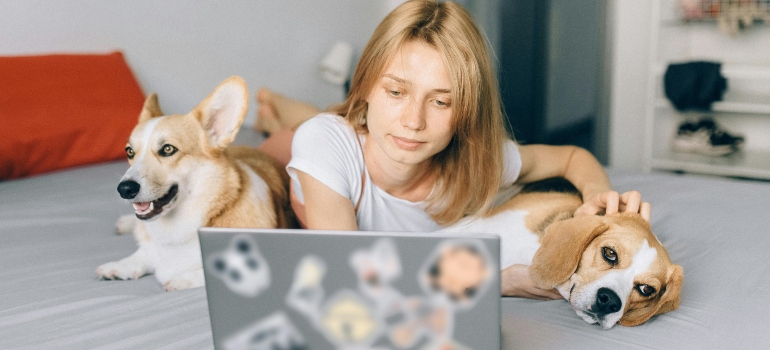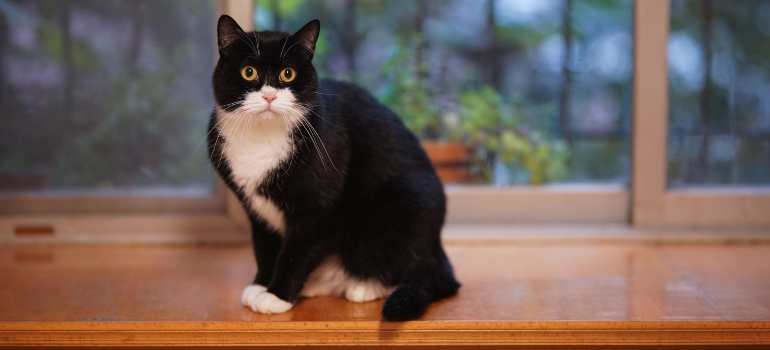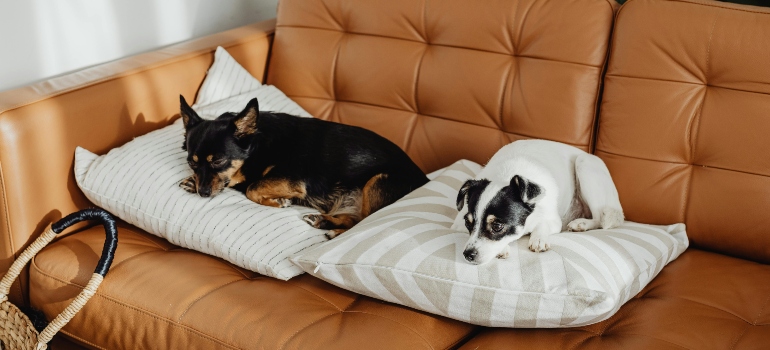How to Pet-Proof Your New Home
Get a QuoteAre you moving with your pets soon? Making your new home a safe and cozy place for them is important. Pet-proofing your new home is more than avoiding dangers; it’s about creating a space where you and your pets can live happily. Picking a Dulles, VA moving company familiar with pet needs is smart. This guide will help you pet-proof your new home, covering everything from identifying indoor hazards to making outdoor areas safe for their enjoyment.
What Are the First Steps in Pet-Proofing Your New Home?
When pet-proofing your new home, first look around from your pet’s point of view. Get down low to spot dangers like loose wires, small things they could swallow, or sharp corners. Make sure windows and doors shut tightly so your pet can’t get out. Putting child-proof locks on cabinets and using trash cans with tight lids will keep your pets away from things they shouldn’t get into.

Which Common Household Items Pose Risks to Pets?
Pets are naturally curious and might eat things that are bad for them or even dangerous. To keep them safe, you need to pet-proof your new home by getting rid of these possible hazards:
- Cleaning Supplies: Household cleaners with chemicals like bleach and ammonia can be toxic if pets ingest them or if they touch their skin. Keep these stored safely away.
- Medications: Human medicines, including painkillers (ibuprofen, acetaminophen) and antidepressants, can be very harmful to pets, even in small amounts.
- Toxic Foods: Some human foods can be dangerous for pets:
- Chocolate (contains theobromine)
- Grapes and raisins (can cause kidney failure in dogs)
- Onions and garlic (can cause anemia in dogs and cats)
- Xylitol (a sweetener found in many sugar-free products, highly toxic to dogs)
- Small Batteries: Button batteries can cause chemical burns and poisoning if swallowed.
- Personal Items: Small everyday items can become choking hazards or cause intestinal blockages if swallowed:
- Socks and underwear
- Rubber bands and hair ties
- Small toy parts
- Jewelry
Keep these items in secure places pets can’t reach. Regularly check your home for any items that could be dangerous and keep your home tidy to reduce risks. Also, let your residential movers in Springfield VA know which boxes have these items to help keep your pet safe and healthy during the move.
How Do You Keep Electrical Cords and Small Objects Out of Reach?
Electrical cords and small objects can pose significant risks to pets, leading to electric shock or choking hazards. Use cord organizers or protective covers to keep cords out of reach and check regularly for any signs of chewing. Ensure that small objects, such as jewelry, coins, and children’s toys, are stored away safely when not in use.
Which Household Plants Are Toxic to Pets?
Many common household plants are toxic to pets and can cause a range of symptoms from mild irritation to severe poisoning. Lilies, sago palms, and philodendrons are just a few examples. Research the plants in your home and garden to ensure they are pet-safe and consider replacing toxic plants with pet-friendly alternatives.

What Types of Flooring Are Best for Pet Owners?
Hard floors, such as tile, laminate, or specially treated hardwood, are durable and easy to clean, making them ideal for homes with pets. If you prefer carpet, select a low-pile option that’s less likely to trap pet hair and dander.
If you have bulky and heavy furniture you have to move to your new home, our experienced movers can take care of all the heavy lifting while you focus on the well-being of your animal companion.
What Measures Should Be Taken to Secure Outdoor Spaces for Pets?
Make sure outdoor spaces are safe for your pets to explore. Here are some steps you can take:
- Install Secure Fencing: Put up fencing high enough so your pet can’t jump over it and deep enough into the ground so they can’t dig underneath. This will help keep your pet in and unwanted visitors out.
- Remove Hazardous Plants and Substances: Some plants and chemicals can harm pets if they eat or get them on their skin. Take time to learn the dangerous ones and remove them from your yard. Also, keep things like fertilizers, pesticides, and antifreeze out of reach.
- Provide Shade and Water: Pets can get too hot outside, especially in the summer. Make sure there are shaded areas where they can cool off. Always have fresh water available to help them stay hydrated.
- Check for Dangers: Regularly walk around your outdoor spaces to look for anything that might hurt your pet. This could be sharp objects, holes in the fence, or trash that has blown into the yard. Fix any problems right away.
With these steps, you can create a safe and enjoyable outdoor area for your pets. This lets them have fun outside while you have peace of mind knowing they’re safe.

Pet-Proof Your New Home To Keep Your Furry Friend Safe
To pet-proof your new home correctly, you have to be vigilant and adaptable as you and your pet settle into your new environment. By taking the necessary precautions and using the services of our Springfield VA local movers who understand how to navigate the logistics of moving with a pet, you can create a safe, comfortable, and enriching space for your pets. This protects them from harm and gives you peace of mind, knowing that your beloved companions are safe and happy in their new home. Remember, a pet-proofed home is a happy home for you and your pets.
